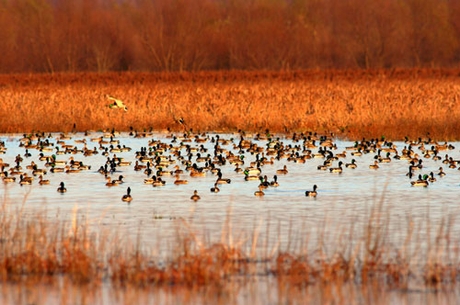It’s almost the end of the calendar year, but still about mid-stream for the ducking hunting season in Texas. The early part of the season was hit and miss for some waterfowlers, but the late season is typically stronger when it comes to ducks and geese on the ground in Texas. The High Plains Mallard Management Unit hunting reports sounded fair, with goose hunters enjoying better decoying action near Dumas, Spearman and Amarillo with the snow and colder conditions.
Christmas Day brought four inches of snow on the High Plains which encouraged geese to decoy better. Larger Canada geese are showing with frozen ponds in the northern states. Snow geese and Canadas are solid on roost ponds near Etter. Duck numbers continue to build in the Panhandle, with more mallards showing on playas. Many divers are hanging out on reservoirs and other deep water ponds. Feed lot ponds are good for gadwalls and wigeons. Recent snow runoff has put water in many dry playas. Outfitters have said hunter participation has been down. Prospects are good in the near term for Panhandle duck hunting action.

In Texas’s North Zone, duck hunters have taken good numbers of mallards in sloughs, creeks and river bottoms, especially with improved habitat conditions as of a result of recent rains, reported biologist Jared Laing. Colder weather and frozen waterways to the north have encouraged more mallards to cross the state line. Scouting has been crucial, said Laing, with birds moving about with more water on the ground. Canvasbacks and other divers have been steady on Lake O’Pines, Toledo Bend and Lake Fork.
The duck hunting in the backwaters of Sam Rayburn, Toledo Bend and the Sulfur River have produced good mallard shoots as well. Gadwalls and wigeons have been taken in shallow coves of lakes and reservoirs. Wood ducks have been steady at first light in wet timber. Hunting remained steady around the zone boundaries of IH-10 where some areas received 2-4 inches during the holiday weekend. Freshwater impoundments have held pintails, wigeons, shovelers and green-winged teal. Prospects are good until the end of the season.
In Texas’ South Zone, the coast offers the most. It continues to produce steady duck shoots on the prairies, marshes and bays. Gadwalls, wigeons, shovelers and pintails have been steady near Eagle Lake, Garwood and Wharton. Most of the upper coast received two to four inches of rain over the holiday weekend. Sheet water has covered many dry rice fields which has encouraged ducks to work goose spreads. Bay hunters enjoyed steady shoots near Port O’Connor and Rockport. Solid shoots have come from the Lower Laguna Madre around Port Isabel and Port Mansfield.
Pintails, redheads, bluebills, gadwalls and wigeons have made up the bags. Hunters in Trinity Bay have struggled the past few weeks as ducks are here today and gone tomorrow. Marsh hunters in Orange County have seen good numbers of gadwalls and teal throughout the season. Snow goose hunting has been good with wind and a low ceiling. Absent have been large concentration of small Canadas that take up the slack for call-shy specklebellies. Sandhill crane numbers are steady. Most cranes have been harvested by goose hunters in white spreads. Duck and goose prospects are really good until the end of the season, especially for marsh hunters.
Duck Hunting Season Dates and Bag Limits: The High Plains Mallard Management Unit runs Oct. 29-30, Nov. 4-Jan. 29, 2012. The North and South zones run Nov. 5-27 and Dec. 10-Jan. 29, 2012.
The daily bag limit shall be 6 ducks, to include no more than the following: 5 mallards (only 2 of which may be hens), 3 wood ducks, 2 scaup (lesser scaup and greater scaup in the aggregate), 2 redheads, 2 pintails, 1 canvasback, 1 dusky duck (mottled duck, Mexican-like duck, black duck and their hybrids are closed the first five days of the duck hunting season in each zone). All other duck species: 6.